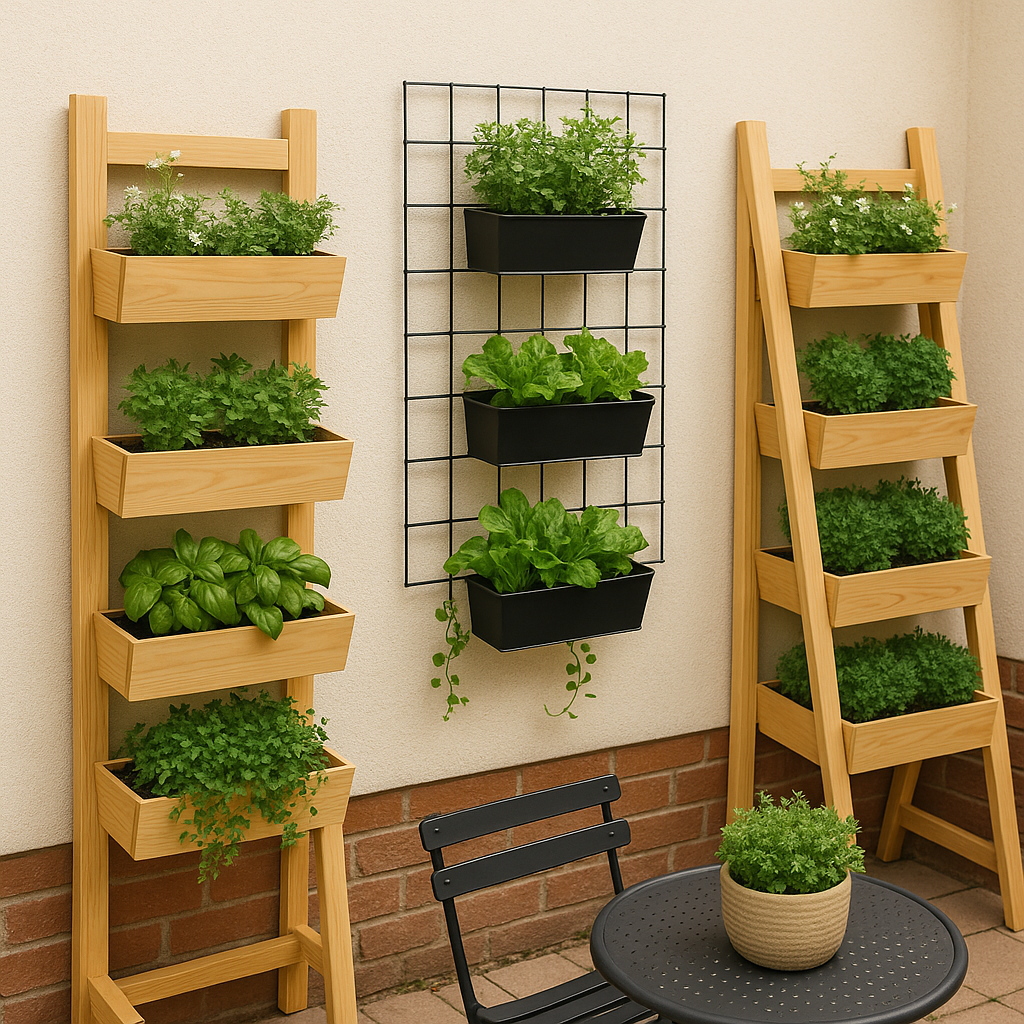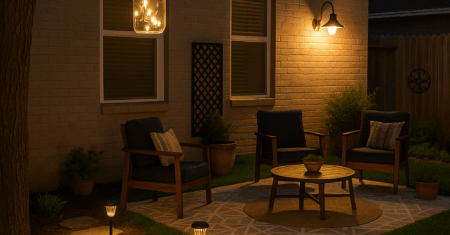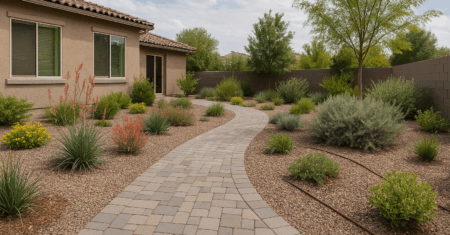DIY Vertical Garden Systems for Small Patios: Space-Saving Solutions

As we explored in our Complete Guide to Low-Maintenance Landscaping, making the most of limited outdoor space has become essential for today’s home gardeners. For apartment dwellers, townhouse owners, and anyone with a small patio or balcony, the solution often lies not in expanding outward, but in growing upward. DIY vertical garden systems for small patios offer an innovative way to maximize your growing area without requiring additional square footage.
The statistics tell the story: according to the National Gardening Association, the average apartment balcony in the United States measures just 40 square feet—barely enough room for a bistro set and a few potted plants. Yet by implementing vertical gardening techniques, you can triple your growing space while creating a stunning visual feature that enhances your outdoor living area. Whether you’re looking to grow fresh vegetables, create a privacy screen with climbing plants, or establish a convenient kitchen herb garden, vertical gardening systems provide practical solutions that work even in the most compact urban settings.
This specialized guide will walk you through the most effective DIY vertical garden options specifically designed for small patios, balconies, and limited outdoor spaces. You’ll discover how to select the right system for your needs, which plants thrive in vertical environments, and step-by-step instructions for creating beautiful, space-efficient gardens that transform your modest outdoor area into a productive growing space and visual sanctuary.
What You’ll Learn About Vertical Garden Systems 📋
Looking to maximize your small outdoor space? This guide dives deep into DIY vertical garden solutions that are perfect for compact patios and balconies. For a broader overview of space-efficient landscaping concepts, check out our Complete Guide to Low-Maintenance Landscaping.
- 🛠️ DIY trellis designs – Simple weekend projects using affordable materials
- 🌱 Best climbing plants – Vegetables, herbs, and ornamentals suited for vertical growth
- 🏗️ Wall-mounted systems – Secure installation techniques for renters and homeowners
- 💧 Irrigation solutions – Water-smart approaches for vertical gardens
- 🍃 Privacy screens – Plant selection and training for natural barriers
This focused guide will help you implement specific vertical gardening techniques tailored to small spaces, transforming your limited patio into a productive growing area without overwhelming maintenance requirements.
Why Vertical Gardening Makes Sense for Small Spaces
The rising popularity of vertical gardening in urban environments isn’t just about aesthetics—it’s a practical response to limited space. A 2022 study by Urban Horticulture Magazine found that implementing vertical growing systems can increase planting area by 300-700% in the same footprint, making it the most efficient solution for small outdoor spaces.
For context, the average American patio or balcony measures between 30-80 square feet, with urban apartments often featuring balconies as small as 4’x6′. These compact spaces might initially seem unsuitable for meaningful gardening, but vertical approaches completely change the equation. By utilizing walls, railings, fences, and vertical structures, you transform previously unused space into productive growing areas.
Beyond space efficiency, vertical gardens offer several advantages particularly beneficial in small settings:
- Improved airflow – Plants growing vertically typically experience better air circulation, reducing fungal issues common in crowded ground-level plantings.
- Enhanced accessibility – Raised growing areas mean less bending and stooping, making gardening more comfortable, especially in tight spaces.
- Microclimatic benefits – Vertical plantings against walls often benefit from thermal mass effects, extending growing seasons in colder climates.
- Physical barriers – Living walls and trellises create natural privacy screens and wind protection, enhancing the usability of your small patio.
“Vertical gardening isn’t just a space-saving technique; it’s a complete rethinking of how we utilize the cubic footage of our outdoor areas,” explains Maria Rodriguez, urban garden designer and author in Chicago. “Most people only think in square feet, but when you begin thinking in cubic feet—utilizing height—you unlock tremendous potential even in the tiniest spaces.”
As you plan your vertical garden system, consider your specific space constraints, sun exposure, weight limitations (especially important for balconies), and aesthetic preferences. The following sections will guide you through selecting and implementing the right vertical solutions for your unique small patio or balcony.
🌿 Building Simple DIY Trellises for Climbing Vegetables
Creating effective support structures is the foundation of successful vertical gardening. For small patios, lightweight yet sturdy trellis systems provide the perfect framework for growing climbing vegetables while maximizing limited space.
Materials Comparison for DIY Trellis Construction
| Material | Pros | Cons | Best For |
|---|---|---|---|
| Bamboo | Natural look, lightweight, affordable | Less durable outdoors (2-3 seasons) | Seasonal vegetables, temporary structures |
| PVC Pipe | Waterproof, durable, easily cleaned | Artificial appearance | Long-term structures, heavier vegetables |
| Wood Lattice | Attractive, readily available | Requires maintenance to prevent rot | Ornamental climbing plants, traditional aesthetics |
| Metal Cattle Panels | Extremely durable, holds heavy crops | Higher cost, industrial look | Perennial climbers, heavy producers like cucurbits |
| Repurposed Items (old ladders, bed frames) | Eco-friendly, unique appearance | Variable stability, may require modifications | Creative gardens, conversation pieces |
Step-by-Step: A-Frame Trellis for Small Patios
The A-frame design is particularly well-suited for small spaces because it provides growing surfaces on both sides while remaining self-supporting—perfect for placement at the edge of a patio.
- Gather materials:
- Two 6-foot lengths of 1-inch PVC pipe (or bamboo poles)
- Two 3-foot lengths of the same material
- Four elbow connectors (for PVC) or twine (for bamboo)
- Garden netting or twine for cross-supports
- Cable ties or garden twine for securing
- Assemble the frame:
- Connect the 6-foot pieces to form two long sides
- Attach the 3-foot pieces at the top and bottom to create an A-shape
- Ensure the bottom piece sits flat for stability
- Add climbing support:
- Stretch garden netting across both sides of the frame
- Secure with cable ties every 6-8 inches
- For bamboo versions, create a grid pattern with garden twine
- Secure and position:
- Place in a container with at least 12 inches of soil depth
- Position the trellis where it receives appropriate sunlight for your chosen vegetables
This simple structure can support 4-6 climbing vegetable plants like cucumbers, beans, or peas—providing approximately 24 square feet of growing space while occupying just 3 square feet of your patio floor.
Pro Tip: For apartment balconies with weight restrictions, construct your trellis to distribute weight evenly against the wall rather than relying solely on container weight. Wall-anchored systems can support more vegetation without exceeding floor load limitations. Just be sure to use appropriate anchoring methods that won’t damage the building structure or violate rental agreements.
The beauty of this system lies in its adaptability. The same structure works for growing best climbing vegetables for apartment balconies in spring and summer, then can be easily modified to support cold-weather crops like snow peas in fall, or stored flat during winter months when your patio usage changes.
🌱 Best Climbing Plants for Vertical Gardens in Small Spaces
Selecting appropriate plants is crucial for successful vertical gardens on small patios. The ideal candidates grow upward naturally, produce well in limited soil volumes, and offer continuous harvest or visual interest throughout the growing season.
Top Performing Edibles for Vertical Systems
Vegetables:
- Cucumbers (Compact varieties like ‘Spacemaster’ or ‘Bush Pickle’)
- Pole Beans (‘Kentucky Wonder’, ‘Scarlet Runner’)
- Indeterminate Cherry Tomatoes (‘Sweet 100’, ‘Sungold’) with proper support
- Peas (‘Sugar Snap’, ‘Oregon Giant’) for spring and fall growing
- Small Melons (‘Minnesota Midget’, ‘Blacktail Mountain’) with sturdy support
Herbs:
- Trailing Rosemary
- Climbing Nasturtiums (edible flowers and leaves)
- Vining Thyme varieties
- Oregano (can cascade in hanging systems)
- Mint (best contained in vertical systems to prevent spreading)
A study conducted by Urban Harvest found that a 4-square-foot vertical vegetable garden can produce approximately 8 pounds of vegetables per growing season—comparable to 16 square feet of traditional garden space. This efficiency makes vertical edible gardens particularly valuable for small patios where every inch counts.
For those seeking privacy along with productivity, certain climbing plants serve double duty as beautiful screens. Scarlet runner beans produce vibrant red flowers that attract hummingbirds while providing a dense green barrier. Annual vines like hyacinth bean offer purple blossoms and decorative pods, while creating an effective privacy screen within weeks of planting.
When planning your vertical herb garden wall kitchen adjacent, consider both culinary use and growing conditions. Mediterranean herbs like rosemary, thyme, and oregano thrive in the drier, warmer conditions often found on patios that receive reflected heat from buildings. These herbs actually perform better in vertical systems where their roots aren’t constantly wet.
For season-long visual impact while maintaining functionality, consider companion planting in your vertical garden. Pair ornamental sweet potato vine with cucumbers, or flowering nasturtiums with pole beans. This approach maximizes both beauty and productivity in your limited space.
Remember that plants growing vertically often have different watering needs than those in conventional containers. Their growing medium drains more quickly, and plants may be exposed to more wind, increasing water requirements. Clustering similar plants together on your vertical system helps manage these needs efficiently.
As discussed in our Complete Guide to Low-Maintenance Landscaping, choosing plants adapted to your specific climate and conditions is essential for low-maintenance success. Regional adaptation is particularly important for vertical gardens where stress factors can be amplified.
🏢 Creating a Vertical Herb Garden Wall for Kitchen Access
For small patios adjacent to kitchens, a dedicated herb wall provides both culinary convenience and aromatic enjoyment. Creating a vertical herb garden wall for kitchen access combines functionality with space efficiency, bringing fresh flavors literally within arm’s reach.
Materials Needed:
- Wooden pallet or pre-made vertical planter
- Landscape fabric
- Staple gun and staples
- Potting soil designed for containers
- Selection of culinary herbs
- Optional: paint or stain for wood treatment
- Small drip irrigation system or water reservoir
Step-by-Step Installation Process:
- Prepare your structure:
- For pallet method: Sand rough edges, then apply non-toxic exterior stain or paint if desired
- Staple landscape fabric to the back and bottom, creating pouches for soil
- For pre-made planters: Assemble according to manufacturer instructions
- Position carefully:
- Place against a wall receiving 4-6 hours of sunlight (morning sun is ideal for most herbs)
- Ensure the structure is secure and won’t tip when watered
- Consider proximity to kitchen door for easy harvest
- Install irrigation:
- Run small diameter drip tubing along the top of each planting row
- Install drip emitters at each plant location
- Connect to timer for consistent moisture
- Plant strategically:
- Position drought-tolerant herbs (rosemary, thyme) at the top
- Place moisture-loving herbs (basil, parsley) in lower sections
- Allow trailing varieties (oregano, creeping thyme) to cascade
- Leave room for growth between plants
Maintenance Tips for Vertical Herb Walls
Herb walls require specific maintenance to thrive in vertical settings:
- Regular harvesting: Frequent cutting encourages bushier growth
- Seasonal rotation: Replace cool-season herbs with heat-tolerant varieties in summer
- Fertilization: Apply liquid fertilizer at half-strength monthly during growing season
- Selective replacement: Individual herbs can be replaced without disturbing the entire system
- Wind protection: In exposed locations, consider occasional shielding during extreme weather
Sarah Jensen, a container garden specialist from Portland, Oregon, shares her experience: “My vertical herb wall transformed an unused side of my tiny apartment patio into the most productive garden feature I’ve ever created. The key was setting up a reliable watering system from the start. With a simple timer and drip irrigation, my herbs thrived with minimal attention, and I had fresh herbs available right outside my kitchen door for cooking nearly year-round.”
For weight-conscious installations (particularly important for balconies and roof gardens), modern fabric pocket systems offer lighter alternatives to traditional wooden structures while still providing adequate growing space for herbs. These systems weigh significantly less when wet and can be more easily moved seasonally as needed.
🛡️ Creating Privacy Screens with Climbing Plants on Trellises
For many small patio owners, privacy is as important as growing space. Strategic use of privacy screen plants for trellis systems creates natural barriers that serve multiple functions while enhancing your outdoor experience.
Selecting Privacy Plants for Different Regions
Regional adaptation is crucial for low-maintenance vertical screens. Consider these climate-appropriate options:
Northeast/Midwest (Zones 4-6):
- Annual: Morning glory, Cardinal Climber
- Perennial: Hardy Kiwi, American Bittersweet
- Semi-evergreen: Baltic Ivy, Boston Ivy
Southeast/South (Zones 7-9):
- Annual: Hyacinth Bean, Black-eyed Susan Vine
- Perennial: Crossvine, Passion Flower
- Evergreen: Carolina Jessamine, Confederate Jasmine
Southwest/West (Zones 8-10):
- Annual: Moon Flower, Malabar Spinach
- Perennial: Pink Jasmine, Bougainvillea
- Evergreen: Star Jasmine, Trumpet Vine
Pacific Northwest (Zones 7-9):
- Annual: Scarlet Runner Bean, Cup and Saucer Vine
- Perennial: Honeysuckle, Clematis
- Evergreen: Climbing Hydrangea, Potato Vine
Addressing Common Challenges
Limited Root Space:
When creating privacy screens in containers, root volume becomes a limiting factor. To address this challenge:
- Use containers at least 18″ deep and 18″ wide for perennial climbers
- Install a reservoir watering system to provide consistent moisture
- Apply mulch to reduce evaporation and moderate soil temperature
- Choose plants with less aggressive root systems for container culture
Seasonal Transitions:
For year-round privacy in regions with distinct seasons, implement a layered approach:
- Combine deciduous flowering vines for summer screening with evergreen components
- Use retractable screens during winter months when plants are dormant
- Consider a mixed planting of fast-growing annuals with slower developing perennials
Important Note: When creating privacy screens on balconies or rental properties, always check building regulations and lease agreements. Many multifamily dwellings have restrictions on attaching trellis systems to building exteriors. For these situations, freestanding or rail-mounted options provide alternatives that won’t violate terms or damage property.
For situations requiring immediate privacy, fast-growing annual vines like morning glory or hyacinth bean can create effective screens within 4-6 weeks of planting. These can be used while slower-growing perennial options become established, then phased out in subsequent seasons.
Some climbing plants, particularly in the Southeastern and Southwestern regions, can become aggressive if not properly maintained. To keep privacy screen plants within bounds:
- Install root barriers in in-ground applications
- Choose sterile cultivars of potentially invasive species
- Practice regular pruning during the growing season
- Remove seed heads before they mature if self-seeding is a concern
For additional strategies on managing small-space gardens effectively, see our related article on Container Gardening for Urban Balconies.
Bringing It All Together: Integrated Vertical Garden Systems
Creating a cohesive vertical garden on a small patio involves integrating different techniques to maximize both productivity and enjoyment of your limited space. The most successful small-space vertical gardens combine multiple approaches tailored to specific light conditions, usage patterns, and aesthetic preferences.
After implementing the strategies covered in this guide, you’ll transform your limited outdoor space into a three-dimensional garden that serves multiple purposes:
- Productive food growing area – With climbing vegetables, herbs, and edible flowers
- Visual enhancement – Creating a living green backdrop that makes your space feel larger
- Privacy solution – Establishing natural screens that block unwanted views
- Microclimate improvement – Plants can buffer wind, provide cooling, and filter air
- Mental health benefit – Research shows that surrounding yourself with plants reduces stress
Remember that successful vertical gardens in small spaces require planning for their specific challenges:
- Water management is critical, as vertical systems dry out more quickly than ground-level plantings
- Weight considerations matter, especially on balconies with structural limitations
- Seasonal transitions require forethought to maintain interest year-round
- Maintenance access must be incorporated from the beginning
As you’ve seen in our Complete Guide to Low-Maintenance Landscaping, thoughtful design choices upfront lead to dramatically reduced maintenance later. For vertical gardens specifically, this means selecting appropriate plants for your conditions, installing efficient irrigation, using quality materials for structures, and creating easy access for necessary care.
Your next steps should include:
- Assessing your specific space conditions (light, exposure, weight limitations)
- Selecting the vertical systems that best match your needs and abilities
- Creating a planting plan that provides continuous interest and productivity
- Installing efficient support systems (particularly irrigation) from the beginning
- Starting small and expanding as you gain experience with vertical gardening
With these elements in place, you’ll join the growing number of small-space gardeners who have discovered that limited square footage doesn’t have to mean limited gardening opportunities. By thinking vertically, you can create an abundant garden that thrives in even the smallest urban patio.
Frequently Asked Questions About DIY Vertical Garden Systems
🌱 How much weight can my balcony or patio handle with vertical gardening systems?
This varies significantly by building construction. Standard residential balconies in the U.S. are typically designed to support 50-100 pounds per square foot. To stay safe: distribute weight evenly, position heavier elements near load-bearing walls, and choose lighter materials like fabric pocket planters when possible. For rentals or condos, check your building’s guidelines before installing substantial systems.
💧 How do I water vertical gardens efficiently without creating a mess?
Drip irrigation with timers is the most efficient solution for vertical gardens. For budget options, consider: self-watering systems with reservoirs, water-wicking setups that draw moisture upward from a basin, or installing collection trays beneath wall-mounted planters. Morning watering reduces evaporation and minimizes moisture on foliage that can lead to fungal issues.
🍅 Can I really grow vegetables vertically in such limited soil volume?
Absolutely! Many vegetables thrive in vertical systems with surprisingly little soil. Pole beans, peas, cucumbers, and indeterminate cherry tomatoes are particularly successful. The key is providing adequate nutrition through regular fertilization (typically every 2-3 weeks with half-strength liquid organic fertilizer) and consistent moisture. Vertical vegetable gardens often produce higher yields per square foot than traditional gardens.
🔨 How do I install vertical garden systems without damaging walls or violating rental agreements?
Several options work for renters: freestanding trellis systems that lean against walls without attachment, tension-rod systems that wedge between floor and ceiling, railing-mounted planters that attach with non-permanent clamps, or shepherd’s hook stands for hanging plants. For homeowners wanting non-damaging options, consider French cleats that minimize wall penetrations while supporting substantial weight.
❄️ Can vertical gardens on patios survive winter in colder climates?
In USDA zones 5-7, many vertical gardens can overwinter with proper preparation. Use these strategies: select appropriate perennial plants for your zone, provide additional insulation for root zones (especially important in containers), position against south or west-facing walls that provide radiant heat, and use cold frames or row covers during extreme weather. In zones 3-4, consider dismantling annual systems and bringing perennial plants indoors or into protected areas.
Resources and Next Steps for Your Vertical Garden Journey
Now that you understand the fundamentals of creating DIY vertical garden systems for small patios, you’re ready to transform your limited outdoor space into a productive, beautiful vertical garden. Here are resources to help you implement these ideas:
Essential Reference Materials
Online Resources:
- Complete Guide to Low-Maintenance Landscaping – Our comprehensive overview of space-efficient garden design
- Container Gardening for Urban Balconies – Complementary techniques for small-space gardens
- Water-Wise Systems for Home Gardens – Detailed guidance on efficient irrigation for vertical systems
Books Worth Reading:
- Vertical Gardening: Grow Up, Not Out by Derek Fell – Comprehensive guide to vertical growing techniques
- Small-Space Container Gardens by Fern Richardson – Specialized advice for urban gardeners
Your Action Plan
- Assess your space – Document sunlight patterns, weight limitations, and water access
- Start small – Begin with one vertical system before expanding
- Focus on proper irrigation – This is the most critical system for success
- Choose appropriate plants for your specific conditions and region
- Document your results to refine your approach each season
Have you tried creating vertical gardens in your small outdoor space? We’d love to see your projects!
Share your photos and experiences in the comments below, or tag us on social media with #VerticalGardenSuccess.




0 Comments